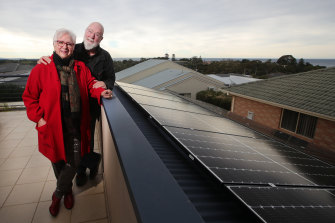
A month ago, this changed, with record levels of interest in all subsidies, including from renters. Demand was strongest in the week of June 6, when a big “tongue” of wintry air escaped from Antarctica and moved over south-eastern Australia, producing a conveyor belt of cold fronts.
The price of home batteries has gone up by about 15 per cent because of the global demand for electric vehicles, says Solar Run managing director Anthony Kurta, whose company is one of the largest installers in Victoria.
But that hasn’t stopped his customers: “The uptake has been fantastic – people are concerned there is not enough power in the grid, and they’re worried about blackouts.”
One of these customers, West Heidelberg resident Robert Montirosso, is an owner/builder who has embarked on building a 9.1-star, highly energy-efficient home. Made from panels of 150-millimetre-thick foam, the all-electric house is unlikely to require heating or cooling, although Montirosso has installed them for comfort if needed. And it now has a new 23-kilowatt rooftop solar system and the first of three batteries that will be fitted over the next year.
Montirosso believes gas and electricity prices will keep increasing, and he worries about the energy grid struggling to cope with demand. Government attempts to manage the transition from fossil fuels could take years, so meanwhile he’s hoping for greater energy security and serious savings.
“I’m a family dude that wants to have a nice house for his kids and partner to live in, and I’m a tight-arse as well,” he says.
As Australia introduces more renewable energy into the grid, storage – both household and system-wide – is crucial. Large-scale batteries, such as Victoria’s “Big Battery” near Geelong, can store electricity when there is an oversupply, so it’s available when demand is high.
But most large-scale batteries only have two to four hours of storage available, so longer duration storage such as pumped hydro will be needed.
Community batteries are an emerging technology, and last month the Yarra Energy Foundation installed Australia’s first inner-urban community batteries in North Fitzroy.

Credit:Matt Golding
Standing on a street corner and the size of four fridges, the lithium-ion battery is designed so the local community of about 200 homes – including those who are unable to install rooftop solar – can access and store renewable energy. This battery absorbs and stores excess energy from rooftop solar during the day and releases it during peak evening times to displace fossil power. It also provides stability to the local grid.
North Fitzroy resident Laura Brinson was interested in the scheme because it included people, like her, who didn’t have solar panels on their houses, and she supports getting more renewable power into the Victorian system.
“I have learnt a lot more about the practical changes you can make in your home, and it has been a really satisfying process to be involved – all of my neighbours are interested.”
The NSW government does not keep detailed data on solar installation, but a spokesperson said that at June 15 there had been more than 3000 applications for solar systems in the “energy bill buster” program, which will provide solar systems and energy efficiency upgrades to up to 30,000 households.
Joan and Ross Hughes decided some time ago to get rooftop solar and a battery for their house in Kiama, two hours south of Sydney, and had the 10-kilowatt system installed this week.

Joan and Ross Hughes had a battery and rooftop solar system installed on their home in Kiama, New South Wales, last week.
Speaking to The Age and The Sydney Morning Herald on a sunny day, Ross Hughes said he’d been checking his meter and was delighted to see his home had not used any mains electricity, despite electrical appliances being turned on.
Although they look forward to cheaper bills, their primary motivation was a strong commitment to sustainable energy.
Loading
“Australia has so much sunshine but federal government policy hasn’t encouraged solar for a long time. We want to use green energy rather than coal-fired power which just adds to greenhouse gases.”
The Morning Edition newsletter is our guide to the day’s most important and interesting stories, analysis and insights. Sign up here.









 Add Category
Add Category